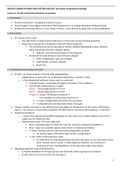Resumen
Samenvatting Applied Computational and Systems Biology (I0J29a)
- Grado
- Institución
Bio-Ingenieurwetenschappen, Master Cellular and Genetic Engineering. De powerpoint, samen met goede lesnotities worden samengevat tot een soort van cursus/samenvatting. De samenvatting volgt dus perfect de powerpoints van de 3 proffen en dus de 3 onderwerpen (Structural Computational Biology, C...
[Mostrar más]



